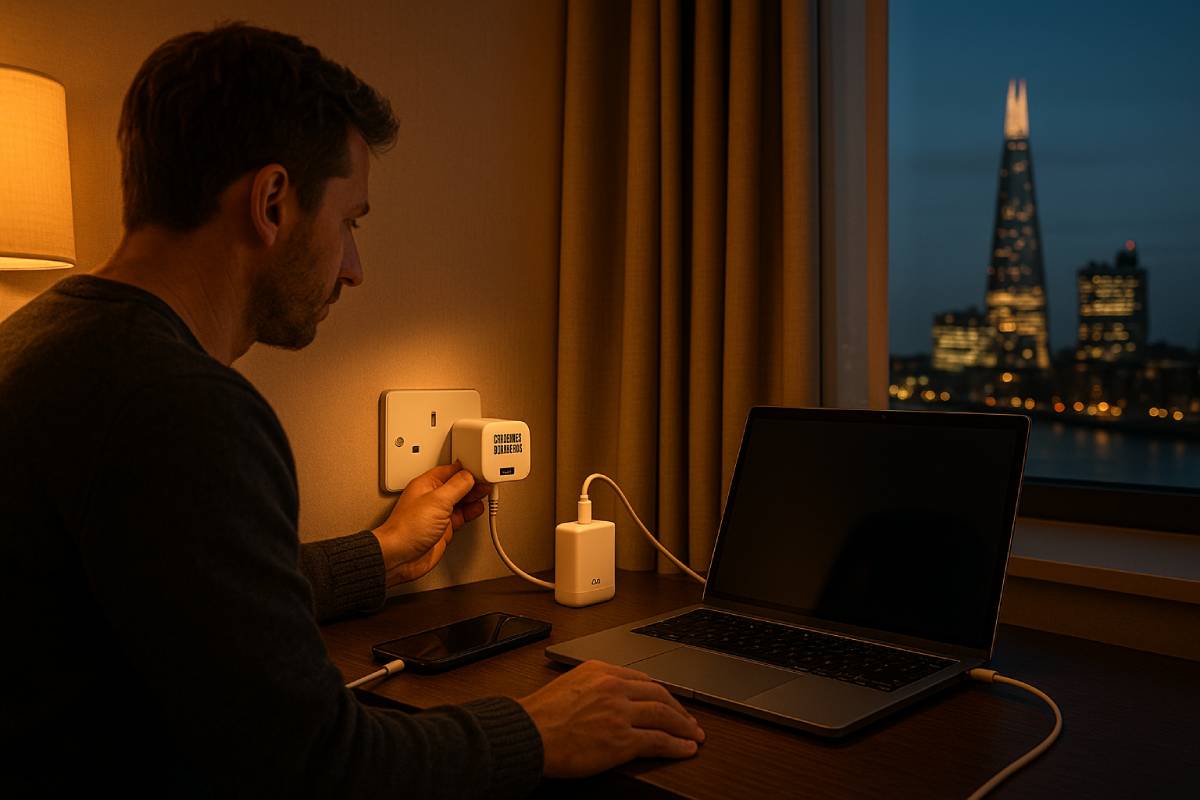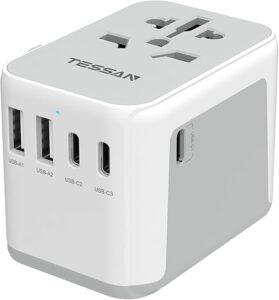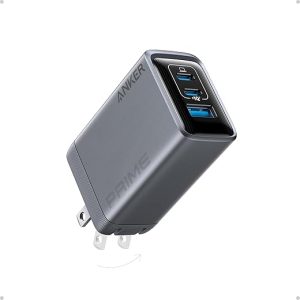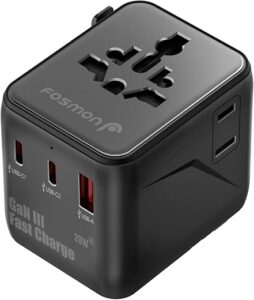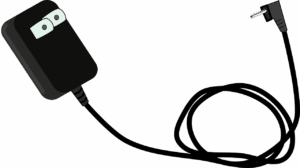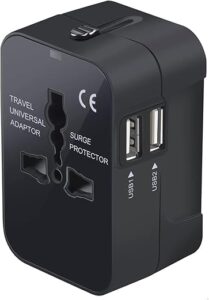“Flying to London? Don’t fry your charger.” The UK uses Type G three-pin plugs and a 230 V/50 Hz mains supply, so you’ll likely need a UK travel adapter—a voltage converter is only necessary if your device isn’t dual-voltage (look for 100–240 V on the label).
For safe, hassle-free charging across England, Scotland, Wales, and Northern Ireland, pack a Type G travel adapter that meets UK safety guidance.
Quick Answer: Do I need an adapter in the UK?
- Yes—if your plug isn’t Type G. The UK uses the three-rectangular-pin Type G plug standard, so travelers from the US/EU/Asia typically need a UK travel adapter to fit local sockets.
- Voltage & frequency: 230 V, 50 Hz. That’s the nominal UK supply used nationwide.
- Converter or not? If your charger or device is marked “INPUT: 100–240 V, 50/60 Hz” (most modern laptops/phones), you only need a plug adapter—no voltage converter required.
- Safety note: UK sockets are shuttered and Type G plugs are fused (BS 1363 design), enhancing safety—but you still must use a compliant adapter.
Specs at a glance
| Spec | Value |
|---|---|
| Plug type | Type G (BS 1363) — 3 rectangular pins; fused plug |
| Mains | 230 V • 50 Hz |
| Socket safety | Shuttered outlets (BS 1363-2) |
| What most travelers need | A Type G travel adapter (no converter for dual-voltage 100–240 V devices) |
Pro tip (SEO-friendly): Before you pack, check your device label for “100–240 V, 50/60 Hz”; if present, add a BS 8546-compliant UK travel adapter to your list for safe, plug-and-play charging in London, Edinburgh, Cardiff, and Belfast.
UK Electrical Basics (Why 230 V matters)
As a rule of thumb, the UK’s mains supply is 230 V at 50 Hz, and—crucially—UK regulations allow a legal tolerance window so what you actually get at the socket can sit anywhere between ~216.2 V and 253 V. That’s why dual-voltage (100–240 V, 50/60 Hz) electronics are fine with just a plug adapter, while single-voltage 110–120 V appliances (like many US hair tools) need a step-down converter to avoid damage.
Practical takeaways
- Nominal supply: 230 V • 50 Hz (country-wide).
- Legal tolerance at the supply point: +10% / −6% ⇒ 216.2–253 V. Expect the upper end (≈250 V) to be common.
- If your device label says “INPUT: 100–240 V, 50/60 Hz”: adapter only; no converter required.
- If your device is 110–120 V only: use a voltage converter (or a UK-bought/dual-voltage alternative).
UK supply at a glance
| Parameter | Value | Notes/Source |
|---|---|---|
| Nominal voltage | 230 V | Declared in UK regulations and supply guidance. |
| Frequency | 50 Hz | Standard across the UK grid. |
| Statutory tolerance | +10% / −6% | Defined in ESQCR context (Reg. 27) and industry docs. |
| Typical allowable range | 216.2–253 V | Utility guidance for homes and businesses. |
Why this matters for travelers: That wide, legal range means a US-only 120 V hairdryer can see up to ~253 V at a UK socket—well beyond its design—so always check the label and pack either a dual-voltage model or a converter, plus a Type G adapter to fit the outlet.
What is a Type G Plug?
As a traveler, think of Type G as the UK’s safety-first plug system: a three-rectangular-pin, fused design defined by the BS 1363 standard. It’s the plug you’ll see everywhere in England, Scotland, Wales, and Northern Ireland—and in many destinations that follow UK standards.
The built-in cartridge fuse (to BS 1362) protects the flex and appliance, while shuttered socket-outlets block access to live parts unless a proper plug is inserted—reducing shock risk in everyday use.
Key points (traveler-friendly)
- Overview: UK plug system = BS 1363 (commonly called Type G).
- Safety design: BS 1362 fuse inside the plug + shuttered sockets that only open for a real plug.
- Why it matters: The fuse limits fault current and the shutters prevent accidental contact—practical safety wins when charging phones, laptops, cameras, and travel gear. (BS 1363 is widely regarded as a very safe system.)
Type G at a glance
| Feature | What it means for you |
|---|---|
| Standard: BS 1363 (Type G) | UK’s national plug/socket system used in homes, hotels, cafés, airports. |
| Pins: 3 rectangular | Earth pin at top; opens socket shutters so live/neutral are only exposed to proper plugs. |
| Fuse in plug: BS 1362 | Built-in cartridge fuse (commonly 3 A or 13 A) protects the cable/appliance from overloads. |
| Socket safety: Shutters | Live/neutral apertures stay closed until a correct plug is inserted—helps prevent foreign-object contact. |
| Rating: Up to 13 A | Suitable for everyday travel electronics and most small appliances when the voltage is compatible. |
Traveler tip: If your device label says “INPUT: 100–240 V, 50/60 Hz”, you only need a Type G travel adapter to fit the socket—the built-in plug fuse and the socket shutters handle the safety side for normal use.
Adapter vs. Converter (Decision Flow)
As a quick rule from the road: read the label on every device before you pack. That single line tells you if you’re fine with a Type G plug adapter or if you’ll need a step-down converter.
- If the label says “INPUT: 100–240 V, 50/60 Hz” → adapter only. Most modern chargers (phones, laptops, cameras) are dual-voltage, so they work on the UK’s 230 V/50 Hz with just a plug adapter. Apple’s USB power adapters, for example, are rated 100–240 V, 50–60 Hz out of the box.
- If the label says “110–120 V only” → adapter + step-down converter (sized for your device’s watts). If your appliance isn’t within the UK’s 230 V range, you must convert the voltage—a plug adapter alone won’t do it.
- High-watt tools (hair dryers, irons, kettles): check wattage and think twice about converters. Hair dryers commonly draw ~1,500–2,000 W; UK kettles are often ~3,000 W—both are heavy loads that require bulky, high-rated converters. Many travelers simply bring a dual-voltage dryer or use the hotel’s and skip converters altogether.
- Safety tip: choose BS 8546-compliant travel adapters for UK/Type G—this is the British standard for safe travel adaptors.
Label Decoder (what to pack)
| Device label (examples) | Do you need a converter? | UK solution | Notes |
|---|---|---|---|
| “100–240 V, 50/60 Hz” (typical phone/laptop chargers) | No | Type G plug adapter | Dual-voltage works worldwide with an adapter (Apple USB adapters are 100–240 V). |
| “120 V 60 Hz only” hair dryer (US model) | Yes | Type G adapter + step-down converter or bring dual-voltage travel dryer | Hair dryers are often 1.5–2.0 kW; high-watt converters are heavy—many travelers use hotel/dedicated dual-voltage models instead. |
| Single-voltage small appliance (120 V) (e.g., US kettle) | Yes (not recommended) | Buy/Use UK-rated version | UK kettles are commonly ~3 kW; using a converter for this load isn’t practical for travel. |
Why this matters in the UK
The UK runs at 230 V/50 Hz (with a statutory tolerance at the supply terminals), so non-dual-voltage 120 V gear will be over-volted without a converter. Always match the voltage first, then use a Type G adapter to fit the socket. For anything you do buy or bring, stick to BS 8546-compliant travel adapters for safer construction, markings, and testing.
Pro packing tip: If you can’t find a clear “100–240 V” line on the brick or plug, assume it’s single-voltage and plan accordingly (converter or local purchase). Your back—and your suitcase—will thank you.
Where Else Is Type G Used? (Trip chaining)
Planning a multi-stop itinerary? A Type G adapter covers far more than the UK. You’ll meet the same three-pin standard across Ireland, Cyprus, Malta, much of Southeast Asia, and most of the Arabian Peninsula—plus parts of Africa—so one quality, BS 8546-compliant adapter can power your whole trip. (Voltage is mostly 230–240 V and frequency 50 Hz; Saudi Arabia is the notable 60 Hz exception.)
Quick planner: popular Type G destinations (voltage & frequency)
| Destination | Voltage | Frequency |
|---|---|---|
| United Kingdom | 230 V | 50 Hz |
| Ireland | 230 V | 50 Hz |
| Cyprus | 230–240 V | 50 Hz |
| Malta | 230 V | 50 Hz |
| Malaysia | 230 V (often 240 V) | 50 Hz |
| Singapore | 230 V | 50 Hz |
| Hong Kong | 220–230 V | 50 Hz |
| United Arab Emirates (UAE) | 230 V | 50 Hz |
| Qatar | 240 V | 50 Hz |
| Saudi Arabia | 230 V | 60 Hz |
| Kenya | 240 V | 50 Hz |
| Nigeria | 230 V | 50 Hz |
| Ghana | 230 V | 50 Hz |
| Oman | 240 V | 50 Hz |
| Kuwait | 240 V | 50 Hz |
Notes for travelers (SEO-friendly tips):
- In the Gulf, Type G is the norm, but some countries (e.g., UAE, Qatar, Kuwait) also have legacy Type C/D sockets—your Type G adapter still keeps you covered in hotels and malls. Always confirm the voltage on your device label.
- Hong Kong is widely Type G; you may occasionally see older Type D in heritage buildings—stick with certified adapters.
Source highlights: WorldStandards country pages; Electrical Safety First travel-adaptor guidance; and country lookup pages confirming voltage and frequency.
Safety & Compliance: What to Buy (and Why)
As a travel pro, I keep this simple: buy a UK travel adapter that explicitly states “Complies with BS 8546”, uses a BS 1362 replaceable fuse in the plug, and mates with shuttered Type-G sockets as intended. That trio covers the essentials of construction, over-current protection, and contact safety in the UK.
What to look for (and why it matters)
| Buy this | Why it matters |
|---|---|
| BS 8546-compliant travel adaptor (printed on the product/packaging) | BS 8546 is the UK safety spec for travel adaptors (including those with USB). It defines construction, rating, markings and tests; it also clarifies that adaptors don’t convert voltage—so you won’t mistake an adaptor for a converter. |
| BS 1362 replaceable fuse inside the plug | UK Type-G plugs are fused by design to protect the flexible cord under fault conditions; common ratings are 3 A or 13 A. A replaceable BS 1362 cartridge fuse is the correct part for BS 1363 plugs and quality adaptors. |
| Shutter-compatible Type-G interface | BS 1363 sockets are shuttered to block live parts unless a proper plug is inserted. Good adaptors are dimensionally correct, so the shutters open normally—no forcing or “pin tricks.” |
| BS 8546 is the UK safety spec for travel adaptors (including those with USB). It defines construction, rating, markings, and tests; it also clarifies that adaptors don’t convert voltage—so you won’t mistake an adaptor for a converter. | These marks show the product claims compliance with applicable electrical safety regulations on the market where it’s sold. Use them in addition to BS 8546, not instead of it. |
What to avoid (with real-world examples)
- “Universal” multi-socket adaptors that accept almost any plug but cite no standard. UK authorities have repeatedly recalled such products for accessible live parts, wrong-size pins, and missing fuses, creating serious shock and fire risks.
- Units with no BS 8546 claim (or vague wording like “tested to UK standards”). If it’s designed for the UK system, BS 8546 should be stated.
Quick buyer’s checklist (copy/paste)
- ✅ Packaging or body says “Complies with BS 8546”.
- ✅ BS 1362 fuse rating printed (typically 3 A or 13 A) and replaceable.
- ✅ Feels solid; pins to BS 1363 dimensions (no wobble, no loose fit).
- ✅ UKCA/CE marking present for the market you’re buying in.
- ❌ No “universal” accept-anything socket faces; avoid products flagged by safety alerts/recalls. (GOV.UK)
Traveler tip: BS 8546 adaptors often include USB ports—handy—but remember, the adaptor still doesn’t change UK voltage. If your appliance is 110–120 V-only, you’ll need a step-down converter (or a dual-voltage model).
Bottom line: A BS 8546 adaptor + BS 1362 fuse + shutter-friendly Type-G design gives you the safest, most reliable experience in the UK—while steering clear of “universal” gimmicks that regulators frequently pull from the market.
Bathrooms & Shaver Sockets (Important!)
In UK bathrooms, ordinary 13 A sockets are generally not allowed near baths or showers. Current wiring regs (BS 7671:2018+A2:2022) only permit a standard socket if it’s outside the bathroom “zones” and at least 2.5 m horizontally from Zone 1, and the circuit must be RCD-protected at 30 mA—so in typical hotel/home bathrooms you’ll rarely see one.
What you will see are “shaver-supply” units: they’re isolated, low-load, dual-voltage (115/230 V) outlets designed for shavers and toothbrush chargers, not hairdryers or other high-wattage appliances.
Key points (traveler-friendly)
- General sockets: Only permitted if ≥ 2.5 m from Zone 1 and on a 30 mA RCD; otherwise prohibited within the bathroom area. Expect none in most bathrooms.
- Shaver sockets (what’s allowed): BS EN 61558-2-5 shaver-supply units are allowed in Zone 2 (where direct spray is unlikely). They’re isolation-transformer outlets with limited output (typically ~20 VA)—perfect for shavers/brushes, not for dryers or laptops.
- Why you still read “3 m”: Older guidance and consumer pages reference 3 m; the 2022 amendment set 2.5 m. When in doubt, follow hotel rules or ask an electrician.
Quick reference: what you can (and can’t) use
| Outlet type in a UK bathroom | Typical marking | Where it’s allowed | What it powers | Use for hairdryer? |
|---|---|---|---|---|
| Shaver-supply unit (isolated) | “Shavers only” • 115/230 V | Zone 2 (away from direct spray) | Low-load devices (shavers, toothbrush chargers) | No — low VA (~20 VA) limit |
| Ordinary 13 A socket | — | Only outside zones and ≥ 2.5 m from Zone 1 with 30 mA RCD | General appliances (when location/compliance allows) | Not in typical bathroom zones |
Buying Tips (Quick Checklist)
As a travel pro, here’s the short list I personally use when picking a UK Type-G travel adapter—kept tight, practical, and safe.
- ✅ “Complies with BS 8546” on the packaging. This is the UK safety standard for travel adaptors (including those with USB). If it’s designed to work with UK plugs/sockets, it should explicitly cite BS 8546.
- ✅ Tight, shuttered Type-G outlet + solid earth pin. BS 1363 sockets are shuttered by design to block contact with live parts; a correctly sized earth pin opens the shutters—so your adaptor must be made to spec for a snug, safe fit.
- ✅ Replaceable fuse (BS 1362) — carry a couple of spares. UK plugs/adaptors use a cartridge fuse (typically 3 A or 13 A) to protect the flex/appliance. If a fuse blows, you should replace it with the same rating. Toss a few spares in your kit.
- 👍 Nice-to-have features: 2+ USB-A/USB-C ports and USB-C PD output that matches your phone (see table), plus foldable pins for packing. For reference, Apple recommends 20 W or higher for iPhone fast charge; Google lists up to 27 W wired on Pixel 8 with its USB-C charger.
- 🚫 Skip “universal” accept-anything sockets (no clear standard). These are repeatedly recalled for accessible live parts, wrong-size pins, and missing fuses—serious shock/fire risks.
Handy power guide (phones)
| Phone family / example | Maker guidance on fast-charge | What to look for on the adaptor |
|---|---|---|
| iPhone (USB-C / Lightning) | 20 W or higher USB-C Power Delivery recommended for fast charging. | A UK Type-G adaptor with USB-C PD ≥ 20 W (and BS 8546 compliance). |
| Google Pixel 8 / 8 Pro | Wired fast charging up to 27 W (with Google USB-C charger). | A UK Type-G adaptor with USB-C PD in the 20–30 W range (BS 8546-compliant). |
Bottom line: For the UK, choose a BS 8546-compliant Type-G adaptor that engages BS 1363 shuttered sockets properly, uses a replaceable BS 1362 fuse, and delivers USB-C PD power that matches your phone. Avoid “universal” sockets with no standard—they’re a safety lottery.
What to Pack (Template)
As a quick, safe load-out for the UK, pack the essentials below. This kit keeps you compliant with BS 8546 (travel adaptors), BS 1363 (Type-G system), and BS 1362 (plug fuses)—and avoids the common pitfalls like unfused, non-standard “universal” blocks.
- 1–2 × Type-G travel adapters (BS 8546)
- Look for the exact wording “Complies with BS 8546” on the body or packaging. This is the UK safety specification for travel adaptors (including those with USB).
- Spare BS 1362 fuses (3 A & 13 A) for your adapter/plug
- Type-G plugs incorporate a BS 1362 cartridge fuse; 3 A and 13 A are the preferred ratings used in UK plugs. Carry a couple of spares in case one blows.
- A dual-voltage hair tool or a travel converter (only if needed)
- If your appliance label shows 100–240 V, you just need an adapter. If it’s 110–120 V only, bring a step-down converter sized for the wattage. (High-watt hair tools are often easier as dual-voltage.) (Wikipedia)
- Compact power strip with a Type-G plug (fused)
- UK plugs are fused by design; choose a quality, ready-assembled bar with a fused Type-G plug and don’t overload it (check the strip’s 10–13 A rating and follow safety guidance).
- Nice-to-have charging: A USB-C PD adapter on the travel adaptor (20–30 W) fast-charges most phones; Apple specifies 20 W or higher for recent iPhones. (Apple Support)
Pack List at a Glance
| Item | Why it matters | Spec to check |
|---|---|---|
| Type-G travel adapter | Fits UK’s BS 1363 socket system; safer construction & markings | BS 8546 on packaging |
| Spare plug fuses | Replaces a blown fuse in your adapter/plug | BS 1362, common 3 A / 13 A |
| Dual-voltage devices | Avoids bulky converters on UK 230 V/50 Hz | Label: 100–240 V, 50/60 Hz |
| Compact Type-G power strip | Adds extra outlets; fused plug = added protection | Fused Type-G plug; 10–13 A rating; ready-assembled |
| USB-C PD charger | Faster phone/laptop charging | ≥20 W PD for iPhone fast charge |
Pro tip: If you’re bringing a strip, use one extension lead per wall socket and never daisy-chain strips—this is a common cause of overheating and fires.
For hassle-free power in London, Edinburgh, Cardiff, and Belfast, carry BS 8546-compliant Type-G adaptors, a few BS 1362 fuses (3 A/13 A), and a compact fused power strip, then match your devices’ labels to the UK 230 V/50 Hz supply to decide whether a converter is actually necessary.
Troubleshooting (Fast Fixes)
- Adapter won’t insert? UK Type G (BS 1363) sockets are shuttered—the earth pin must align and enter first to open the shutters for live/neutral. If your adaptor’s earth pin is the wrong shape/size or you try to angle it in, the shutters may not open. Never force it; use a correctly made adaptor and insert straight in.
- Charger feels slow? Many travel adaptors output only 5 V/1–2.4 A on USB. For fast charging, use a USB-C Power Delivery (PD) wall charger that plugs into a Type G socket (or a BS 8546 adaptor with proper PD output): Apple specifies ≥20 W for iPhone fast-charge; Google notes Pixel charging speed depends on the PD/PPS wattage used (e.g., Pixel 8 up to 27 W with Google’s 30 W charger).
- Blew a fuse? UK plugs/adaptors use BS 1362 cartridge fuses—commonly 3 A or 13 A. After fixing the cause, replace like-for-like with the same BS 1362 rating (don’t “up-fuse”).
Fast fixes at a glance
| Symptom | Likely cause | Quick fix | Why this works |
|---|---|---|---|
| A correct fuse protects the flex/appliance; a like-for-like restores safety. | Shuttered socket needs correct earth-pin engagement | Re-align and insert straight; use a BS 1363-dimensionally correct adaptor | Earth pin operates shutters, forcing risks of damage. |
| Phone charges very slowly | The adaptor won’t go in | Use a USB-C PD charger (≥20 W for iPhone; PD/PPS charger for Pixel) | Meets device fast-charge requirements, increasing speed. |
| No power after a pop | BS 1362 fuse in the plug/adaptor has blown | Replace with the same rating (typically 3 A or 13 A) after checking the load | Earth pin operates shutters, posing risks of damage. |
Pro tip: If a fresh BS 1362 fuse blows again, stop using the device/adaptor and have it checked—repeated fuse operation signals a fault, not something to “fix” with a higher-rated fuse.
For hassle-free charging in the UK, use a dimensionally correct Type G adaptor, pair phones with a USB-C PD charger, and keep a couple of BS 1362 (3 A/13 A) spares in your pouch.
FAQs
Is UK voltage 240 V or 230 V?
230 V nominal. By regulation, UK supply is declared 230 V at 50 Hz with a permitted tolerance window (typically 216.2–253 V at the socket). That’s why older “240 V” references persist, but 230 V is the harmonized standard today.
UK voltage facts at a glance
| Item | Value |
|---|---|
| Declared voltage | 230 V (50 Hz) |
| Typical tolerance at socket | 216.2–253 V (utility guidance) |
Do I need a converter for my MacBook/phone?
Usually no. Most modern phones and laptops (e.g., Apple USB-C/USB power adapters) are dual-voltage 100–240 V, 50/60 Hz, so in the UK you only need a Type-G plug adapter—not a voltage converter. Always confirm on your charger label: “INPUT: 100–240 V, 50/60 Hz.”
Are UK sockets switched?
Many are, but switching isn’t the safety lynchpin. UK sockets are designed to be shuttered (BS 1363), which blocks access to live parts until a proper plug is inserted. While switched outlets are common, the standard explicitly covers switched and unswitched socket-outlets—so the shutter mechanism is the key safety feature, not the presence of a switch.
Can I use bathroom sockets for hairdryers?
No. The outlets you see in UK bathrooms are shaver-supply units with an isolation transformer (dual 115/230 V) and low power limits—they’re intended for shavers and toothbrush chargers only, not high-watt appliances like hairdryers.
General 13 A sockets are normally not allowed in bathrooms, except under strict distance/placement rules; charge power-hungry devices in the bedroom using a Type-G adapter.
Conclusion
Powering up in Britain is simple once you know the rules. The UK’s Type-G system pairs fused plugs with shuttered sockets for safety, while ESQCR sets the supply at 230 V within a defined tolerance—so most modern chargers marked 100–240 V only need a compact adapter, not a converter.
When performance lags, it’s usually the charger, not the wall: a USB-C PD brick (≈20–30 W) restores fast speeds. In bathrooms, stick to shaver-supply units and keep high-watt appliances in regular rooms. Shopping is easy too: choose BS 8546-compliant adaptors with BS 1362 fuses and skip unproven “universal” sockets.
Planning multi-country hops? Type-G also covers Ireland, Malta, Cyprus, Singapore, Malaysia, Hong Kong, the UAE, and more—pack once, roam widely.
Follow these evidence-based steps and you’ll avoid tripped fuses, sluggish charging, and safety scares—arriving with devices ready for maps, photos, and everything your UK trip demands.

